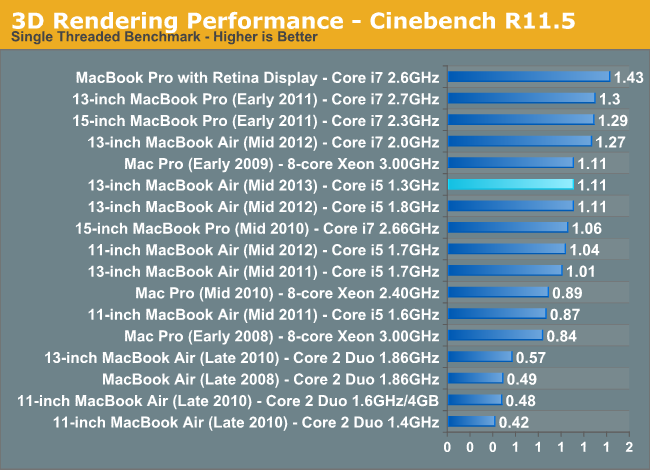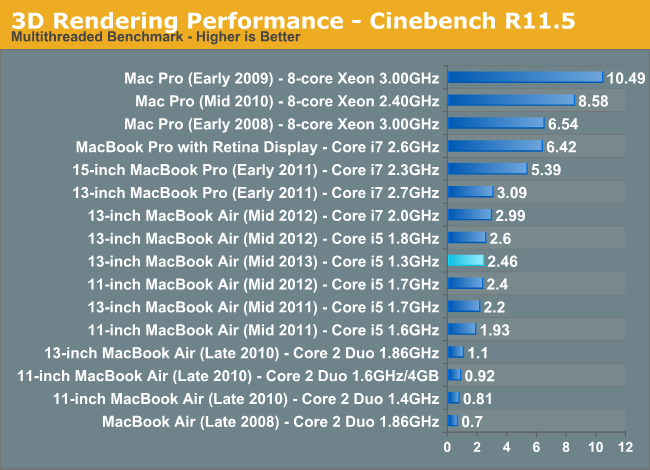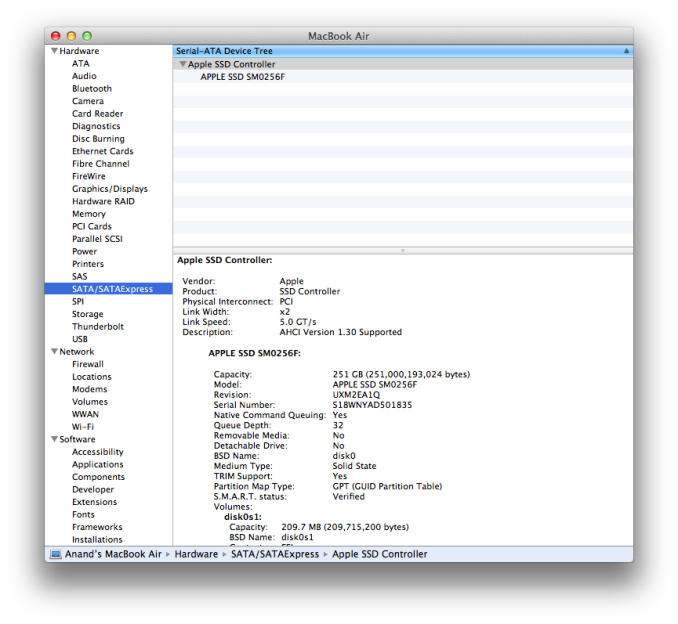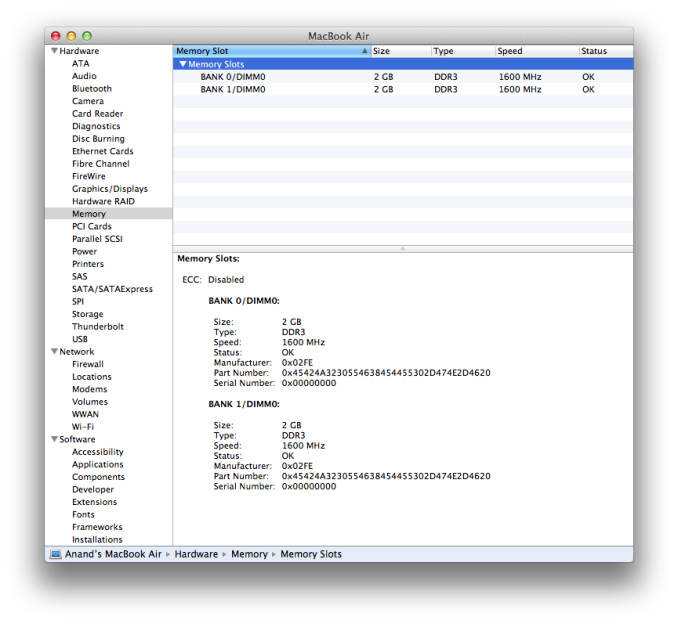2013 MacBook Air: PCIe SSD and Haswell ULT Inside
by Anand Lal Shimpi on June 10, 2013 10:01 PM EST- Posted in
- Mac
- Storage
- SSDs
- Apple
- MacBook Air

This morning Apple updated its MacBook Air to Intel's Haswell ULT silicon. The chassis itself didn't get any updates, nor did the displays. Both the 11 and 13 inch models retain their non-Retina 1366 x 768 and 1440 x 900 displays. There's a slight increase in battery capacity. The 11-inch model moves to 38Wh (8.6%) while the 13-inch model goes to 54.4Wh (8.8%). The big changes however are on the CPU, NAND and DRAM fronts.
With the new MacBook Air, Apple moves to a Core i5-4250U. The base clock drops to 1.3GHz across all of the models, but max turbo remains at 2.6GHz. Although the base clock is lower, I wouldn't expect substantially lower performance since the max turbo is unchanged as is the chassis that has to dissipate the thermals. To confirm, I ran a couple of Cinebench tests and generally found performance similar to that of last year's models:


The 1.8GHz i5 in the 13-inch ended up being a bit quicker than the 1.3GHz 4250U this generation in the multithreaded test, but in single threaded performance the two are equal. The impact on the MT test is about 5%, it's there but not substantial. Don't be fooled by base clock, it's the combination of base clock, max turbo and cooling solution that'll determine performance here. As we found in our Haswell ULT review, CPU performance isn't something you can expect to see more of with Haswell vs. Ivy Bridge in these low wattage platforms.
You can get a 1.7GHz Core i7 upgrade with a 3.3GHz max turbo (i7-4650U). Both parts have Intel GT3 graphics clocked at a max of 1GHz on the i5 and 1.1GHz on the i7. Since the max GPU clocks are south of 1.2GHz, this is officially Intel's HD 5000 graphics and not Iris despite using the same silicon. The GPU base clock drops from 350MHz down to 200MHz, which should help reduce idle power consumption.
| 2013 MacBook Air Lineup | ||||||
| 11.6-inch | 11.6-inch (high-end) | 13.3-inch | 13.3-inch (high-end) | |||
| Dimensions |
H: 0.11-0.68" (0.3-1.7cm) W: 11.8" (30cm) D: 7.56" (19.2cm) |
H: 0.11-0.68" (0.3-1.7cm) W: 12.8" (32.5cm) D: 8.94" (22.7cm) |
||||
| Weight | 2.38 lbs (1.08kg) | 2.96 lbs (1.35kg) | ||||
| CPU | 1.3GHz dual-core Core i5 | 1.3GHz dual-core Core i5 | ||||
| GPU | Intel HD 5000 | |||||
| RAM | 4GB LPDDR3-1600 | |||||
| SSD | 128GB PCIe SSD | 256GB PCIe SSD | 128GB PCIe SSD | 256GB PCIe SSD | ||
| Display Resolution | 1366 x 768 | 1440 x 900 | ||||
| Ports | Thunderbolt, 2x USB 3.0, headphone jack | Thunderbolt, 2x USB 3.0, SD card slot, headphone jack | ||||
| Price | $999 | $1199 | $1099 |
$1299 |
||
On the storage front, Apple officially leads the charge with the move to PCIe based SSDs. The upcoming Mac Pro, as well as the new MacBook Airs both use PCIe based SSDs instead of SATA drives. A quick look at OS X's system profiler reveals a PCIe 2.0 x2 interface, capable of 1GB/s in each direction.
The drive in my system uses a Samsung controller, although I've heard that SanDisk will have a PCIe solution for Apple as well. A quick run through Quick Bench reveals peak sequential read/write performance of nearly 800MB/s:
This is a pretty big deal, as it is probably the first step towards PCIe storage in a mainstream consumer device that we've seen. I'm still awaiting official confirmation as to whether or not this is an M.2 based solution or a proprietary connector. Update: It's a custom Apple design, not M.2. Since there's no PCIe routed off of the CPU in Haswell ULT, these 2 lanes come from the on-package PCH.
The other big change is the move from DDR3L to LPDDR3, a new feature supported by Haswell ULT. I need to go back and dig through the Haswell ULT datasheets again, but I believe the total memory interface width remains at 128-bits wide even if you use LPDDR3 - you just get lower power consumption.
Obviously battery life is the biggest improvement here with the new MacBook Air. Thanks to Haswell's platform power optimizations, Apple claims up to 12 hours on a single charge for the 2013 13-inch MacBook Air. Given the improvements I saw in our Haswell ULT review, I don't doubt that we could see some very good numbers out of these notebooks.
I just got my hands on a 13-inch 2013 MBA and I'll be running performance tests (including the first look at Intel's HD 5000 graphics) over the coming days. I'm still traveling until Thursday but I'll do my best to run battery life tests while I'm on the road as well. More soon!













174 Comments
View All Comments
Sm0kes - Sunday, June 16, 2013 - link
This is nothing new. In the 2012 models Samsung drives were only used on the 256GB models. The 128GB models got Toshiba.HugoWayne - Friday, June 14, 2013 - link
Does the Macbook Air 2013 support DisplayPort 1.2? Can I daisy chain two DisplayPort 1.2 monitors to it?kiwilegal - Saturday, June 15, 2013 - link
Can you test how fast the SD slot is in this new machine. I believe you reported on the 2012 machine that speed was capped at 40MB/s. Is that still the case?MrN1ceGuY - Sunday, June 16, 2013 - link
Hello Lal Shimpi,nice first-look but when can we expect the full review? There are no 3DMarks or serious 3D-test out yet which is really sad.
Sm0kes - Sunday, June 16, 2013 - link
He posted on twitter he is testing now :)Paapaa125 - Monday, June 17, 2013 - link
Which twitter feed you mean?Sm0kes - Monday, June 17, 2013 - link
Anand's twitter feed (@anandshimpi). Several people asked him specific questions (e.g., battery life, i5 vs. i7) and his responses were pretty clear that it's in progress.NonTechGuru - Monday, June 17, 2013 - link
So, as a consumer who is confused by all this information, can someone knowledgable advise if they expect that the MacBook Pro to come out in the fall will be significantly faster than the new MacBook Air, including at bootup? Which would you purchase for consumer usage (documents, movies, music storage and streaming, etc.) at a moderate level (i.e., several hours daily)?NonTechGuru - Tuesday, June 18, 2013 - link
Haha, living up to my username. Just realized that it's the Mac Pro, not the MacBook Pro, that they are updating in the fall.Kill16by9TN - Monday, June 17, 2013 - link
"Update: It's a custom Apple design, not M.2. "Well, according to today's ElReg article "Samsung wins Apple MacBook contract, starts spitting out PCIe SSDs" www.theregister.co.uk/2013/06/17/samsung_pcie_flash_bell_tolling/
Samsung's SSD is called XP941, comes in 128GB, 256GB and 512GB and IS "an M.2 form factor of 80mm x 22mm".